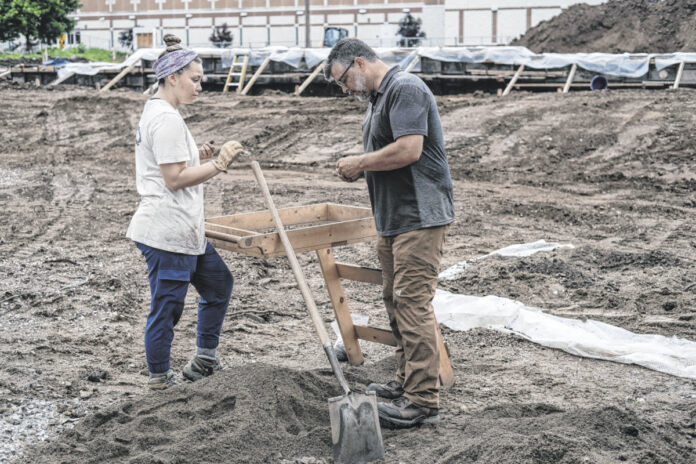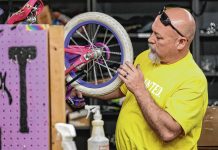
Additional bones, likely human, have been found at the court services center construction site in downtown Columbus, but investigators from the University of Indianapolis do not expect more to be unearthed.
“After our last (redevelopment) meeting, some additional bones were found,” Redevelopment Director Heather Pope said. “They monitored for a couple weeks longer. The monitoring is now complete, and now they are working on the skeletal analysis and hope to have that finished up by the end of this month. And from there, we hope to learn more about the bones.”
The small amount of additional bones found within the last month are believed to be human, Pope said. University of Indianapolis investigators believe that, based on their findings, no bones are now left at the site.
The university has been involved in the investigation and is analyzing both human and animal bones found on the land. The Indiana Department of Natural Resources has also been involved with the case.
Bones were first found on May 18 by construction workers trying to locate a 1940s-era clay sewer line as part of the court services building project at 555 First Street.
The human bones do not make up a complete skeleton, Pope said in a previous interview, and were found about 6- to 7-feet deep, mixed with animal leg bones from pig and cattle that had been severed by some sort of serrated saw.
Since the bones were not found in a casket or burial container, investigators think the bones were moved to the site at an unknown point in time, Sharkey said in an earlier interview. It is unknown why they were found in a somewhat jumbled formation, and why the human bones were not laid out in an anatomically correct way, as would have been expected with a burial.
Rachel Sharkey, a research archaeologist with the Indiana Division of Historic Preservation and Archaeology, said that at least some of the human bones found on the construction site since the initial discovery are believed to be from the Adena culture.
“We haven’t found a lot of diagnostic artifacts to give a definitive time period, but there are some indicators that they are dating to what we like to call the Woodland Period,” Sharkey said.
This period, she said, dates from about 1,000 B.C. to 1,200 A.D.
According to the DNR, from 1,000 to 200 B.C, there was a people group in Indiana that is now known as the Adena culture. This name was given to the group by archeologists, who did not know what members called themselves. The term originates from the name of Thomas Worthington’s farm. Worthington lived in Chillicothe, Ohio in the 19th century.
The Adena was not one tribe, but instead probably a “group of interconnected communities living mostly in Ohio and Indiana.” Over a period of 500 years, the Adena culture turned into the “Hopewell tradition,” another set of interconnected groups also named by archaeologists. Some scholars believe that the Hopewell could have later become the people we now know as the Miami or Shawnee.
Sharkey said that they would like to find more artifacts that could help them date the pre-contact remains. The archaeologists have found “a lot of evidence of historic occupation of the area,” she said. A settlement was found about two feet from the surface and included glass, nails and other artifacts dating to the late 1800s or early 1900s.
However, such objects don’t appear to be connected to the bones.
“It definitely appears that the area has been disturbed by construction in the past, and so it’s making it quite a jigsaw puzzle to figure out,” she said.
One of the scenarios being considered is that back in the 1940s, when the clay sewer tile was installed, the workers perhaps came upon a grave site and then simply used the dirt they excavated, including the human bones, as fill dirt on top of the sewer line as they refilled the site, she said. The bones were found above the sewer tile installed in the 1940s, not below it.
“We have seen that happen in the past,” Sharkey said, “And it is within the realm of possibility.”
Sharkey said it is possible that the remains were uncovered during the excavation for the 1940 sewer tile, and that the additional bones from the animals were added in at some point when the line was covered over with the fill dirt.
So far, reburial plans for the human remains have not yet been announced as investigators expect the analysis to take some time. After it’s finished, the University of Indianapolis, the state and the city will work with interested Native American groups to find a proper reburial place.
Pope said that she also believes the university might give a presentation on their findings and process to the community.
Christopher Schmidt with the University of Indianapolis has indicated his interest in engaging with Columbus and teaching the community about the area’s past, which the DNR would also be in favor of, Sharkey said.
Construction work on the new Bartholomew County court services building is still on track to be completed next April, Pope said.




